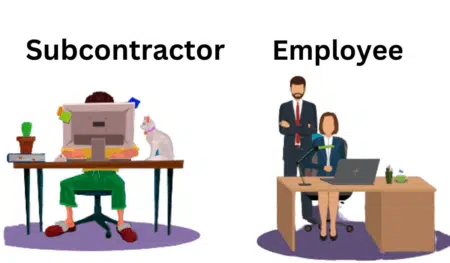Employee vs Subcontractor: Key Differences Unraveled
As a business owner or manager, it’s crucial to understand the biggest differences between the types of workers for tax purposes. Misclassifying a worker can lead to costly fines and penalties and create problems with the IRS. It Matters to the IRS and to you. Therefore, it’s essential to clearly understand the criteria used to determine employee versus subcontractor status. Differentiating subcontractors vs. employees is the most important thing in this regard. This helps you ensure that you’re not setting unreasonable expectations and avoid making mistakes in employment and tax laws. Clarity on these points helps an employer decide which situations demand an employee and when a subcontractor is a better fit for a particular job.
This article will provide a guideline for determining a worker’s classification according to tax law. We’ll outline the key factors that the Internal Revenue Service (IRS) considers when distinguishing employees from subcontractors and discuss the tax implications of each classification.
Employee vs. Subcontractor: What’s the Difference?
Before diving into the criteria for determining whether a worker is an employee or subcontractor, it’s crucial to understand the fundamental differences between the two. Check out our short video employee vs subcontractor Story
An employee performs services for an employer, and the employer controls how the work is performed. The employer is responsible for withholding income and payroll taxes, providing benefits, and complying with various labor laws.
On the other hand, a subcontractor is an individual or business that provides services to another business or individual. Subcontractors are independent contractors and generally considered self-employed and responsible for their own taxes, insurance, and benefits.
The distinction between employees and subcontractors is critical because it affects how taxes are withheld and reported. For employees, employers must withhold income taxes, Social Security taxes, and Medicare taxes. They are also responsible for paying unemployment taxes and complying with various labor laws, such as minimum wage and overtime requirements. One difference between employees and subcontractors is their work schedules. Employees usually have a predetermined work schedule set by their employers, although certain jobs can offer flexibility. Unlike employees, subcontractors usually provide their own tools and supplies to do their jobs, and they are responsible for their own taxes, supplies, and health benefits.
On the other hand, subcontractors who are independent contractors are responsible for paying their own income taxes, Social Security taxes, and Medicare taxes. Their employment status does not qualify them for unemployment benefits or workers’ compensation, and they are not covered by several labor laws that apply to employees.
Therefore, it’s essential to classify workers correctly to avoid penalties and ensure compliance with tax regulations.
An employee:
- Your company sets the time and place
- Works for only one company
- Utilizes your tools or stuff related to your job
- Receives training
- Performs work that’s integral to your business
- Almost all of it is under your control
- In general, it is paid on an hourly or salary basis
Why does it matter? Because several employee benefits are available to employees, including health insurance, paid time off, vacation time, and financial deductions such as income tax and Social Security tax, among others. Employees may also join a union, and they are protected from wage discrimination, overtime, and minimum wage violations by state and federal laws.
Independent contractors:
- Has the flexibility to work wherever and whenever they want
- Working for multiple companies in the same year is also possible
- Employers do not train employees. Instead, they hire for their expertise
- Tools and resources that they use on their own
- The method of work is under their control
- The fee is usually paid by the project or at a flat rate
Why does it matter? Generally, contractors do not receive overtime pay or protection against employment discrimination, do not receive employment benefits, do not pay their taxes, and are not subject to other withholdings.
Criteria Used to Determine Subcontractor vs. Employee Status
The IRS uses criteria to determine whether a worker is an employee or subcontractor. The following factors are considered:
Behavioral control:
Based on employee agreements, employers typically dictate what hours and where employees work. To perform their job, they use the company’s tools and resources. Employees cannot hire someone to assist them; they are not generally authorized to perform the work. Furthermore, if the evaluation system of a company measures each step of the work process, it suggests an employment relationship between the worker and the payer, indicating that the payer controls the financial aspects of the worker’s job, such as how the worker is paid and whether expenses are reimbursed.
Contrary to this, contractors have a higher degree of control over the circumstances surrounding their work, including contract work. Each person decides when and where to work, using their tools (for example, consultants will carry laptop computers, and roofers will bring hammers). It is generally the responsibility of contractors to hire and retain their employees on a regular basis. Finally, a company’s evaluation system should only measure the result of independent contractor status.
Financial Control:
An employee is paid in the form of an hourly wage or a salary determined by their employer. Generally, taxes are withheld each biweekly or monthly from their paychecks. Employers do not receive invoices from employees.
As opposed to employees, contractors invest in their businesses. They pay their expenses, for example. Therefore, their success is financially dependent on it. Contractors may also have different payment terms, including a unique pay structure. Unlike a salaried employee, the contractor is usually paid by time and deliverables. Various methods are used to charge hourly or project-based fees. Half of the fee may be paid upfront, and the second half will be paid 30 days after the project has been completed and an invoice sent out. In addition to retainers, contractors who handle needs regularly are commonly paid in advance. Businesses are not responsible for withholding taxes from contractor payments.
Relationship:
As an employee, you can expect to perform essential work for the company, and your relationship will continue for the rest of your career. You likely have full-time or part-time cooks if you own a restaurant. Someone must prepare the food for the business to be open for business.
Contractors provide short-term, specialized services. In this case, hiring an interior designer to decorate your office space may be necessary, or a grant writer to assist your non-profit in submitting an application for a specific grant opportunity. The IRS generally assumes that there is an employment relationship when in doubt. However, as discussed previously, the line may be ambiguous.
You have to remember that no one factor is determinative. A worker’s classification is determined by the IRS looking at their whole situation.
Tax Implications of Employee vs. Subcontractor Status
Classifying a worker as an employee or subcontractor has significant tax implications. Let’s examine how each classification affects tax withholding and reporting.
Employees
For employees, employers must withhold income taxes, Social Security taxes, and Medicare taxes. Employers are also responsible for paying unemployment taxes and complying with various labor laws, such as minimum wage and overtime requirements.
Employers must provide their employees forms like a Form W-2, which reports their wages, tips, other compensation, and taxes withheld. They must file Form W-2 with the Social Security Administration and provide a copy to the employee by January 31st of each year.
Subcontractors are responsible for paying their income, Social Security, and Medicare taxes. They are not qualified for unemployment benefits or workers’ compensation and are not covered by various labor laws that apply to employees.
Employers must provide subcontractors with a Form 1099-NEC if they pay them $600 or more annually. Start with having your subcontractor fill out the proper subcontractor forms BEFORE you write their first check. You have to have this data to produce their 10099 at the end of the year. This form reports the total payments made to the subcontractor and must be filed with the IRS by January 31st of each year.
Penalties for Misclassification
Misclassifying a worker as an employee or subcontractor can result in costly fines and penalties. The IRS can impose penalties for failing to withhold and pay employment taxes, file required tax forms, and provide required information to workers.
Employers who misclassify workers may also be liable for back taxes, interest, and penalties. In addition, misclassification can result in worker complaints and investigations by government agencies, such as the Department of Labor and the IRS.
Therefore, it’s essential to classify workers correctly to avoid these penalties and ensure compliance with tax regulations.
Steps to Determine Employee vs. Subcontractor Status
Follow these steps to determine if a worker is an employee or a subcontractor:
Determine the level of behavioral control the employer has over the worker.
Ask questions such as:
- Does the employer provide specific instructions on how the work is to be done?
- Does the employer provide training to the worker?
- It is the employer’s responsibility to determine when the work is done and where it is done
- Does the employer provide tools or equipment to the worker?
If the employer has significant control over the worker’s behavior, the worker is likely to be classified as an employee.
Determine the level of financial control the worker has.
- Does the worker have a significant financial investment in their work, such as purchasing tools, equipment, or materials?
- Is the worker reimbursed for their expenses?
- Does the worker have the ability to earn a profit or incur a loss based on their work?
If workers have a significant financial investment in their work and can profit or incur a loss, they are more likely to be classified as subcontractors.
Determine the nature of the relationship between the parties.
- Does the worker receive benefits, such as health insurance or retirement benefits?
- Is the worker eligible for vacation or sick leave?
- Is there an expectation of ongoing work between the parties?
- Does the worker work exclusively for the employer?
If the worker receives benefits or expects ongoing work, they are more likely to be classified as an employee.
Review the totality of the circumstances.
No single factor is determinative, and the IRS looks at the totality of the circumstances to determine the classification of a worker. Consider all the factors and decide based on the overall relationship between the parties.
Conclusion
Correctly classifying workers as employees or subcontractors is essential for tax purposes. Misclassifying workers can result in costly fines and penalties and create problems with the IRS. A worker’s relationship with the employer, behavioral control, and financial control may determine whether they are employees or subcontractors.
Remember that no single factor is determinative, and the IRS looks at the totality of the circumstances to determine the classification of a worker. By following these steps and correctly classifying workers, you can avoid penalties and ensure compliance with tax regulations.
FAQs
What is the difference between an employee and a subcontractor?
The main difference between an employee and a subcontractor is the nature of their working relationship. An employee works directly for a company, follows set hours, and receives benefits, while a subcontractor is self-employed, sets their own hours, and is responsible for their own taxes and benefits.
What taxes do I need to pay for each one?
As an employee, you are responsible for paying income tax, Social Security tax, and Medicare tax. Your employer withholds these taxes from your paycheck. As a subcontractor, you are considered self-employed and responsible for paying self-employment tax, which includes Social Security and Medicare taxes.
How can I ensure that I am classifying workers correctly to avoid legal issues?
To ensure correct worker classification and avoid legal issues, consult an employment lawyer or tax professional. They can help you navigate the complex laws and regulations surrounding employee vs subcontractor classification and provide guidance specific to your business and industry.
When are you an employee versus a contractor?
You are considered an employee when you work for a company on a regular basis, under their supervision and control. On the other hand, you are classified as a subcontractor when you provide services to a company as an independent entity, with more flexibility and autonomy in how the work is performed.
Also Read









